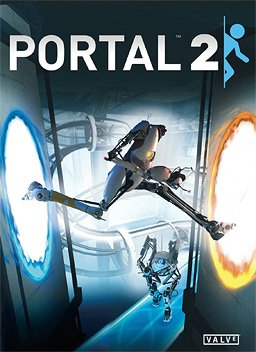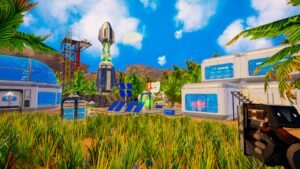Portal 2 is better than the original. It is also probably a safe shoe-in for funniest game of 2011, if such a category existed for game awards. It is smart, it is cruel, it is witty and it will, at every turn, constantly tell players that they are awful people who are fat and orphaned. Not only will you pay for the privilege of being insulted, it will be one of the most memorable experiences you have this year. If you need to find out why, just keep reading.
GLaDOS Is In A Bad, Bad Mood
Portal 2 takes place some frighteningly long and indeterminate time after the original Portal. You’re still the silent Chell (now having had her muteness explained away as a possible case of very minor serious brain damage after extended cryogenic suspension) and you’re still trapped in the Aperature Labs facility. Anything else would be spoiling what is one of the wittiest, passive-aggressive plots in gaming this year, so I’ll go no further. But with that framework in mind, it’s safe to say yes, portal guns will be acquired, puzzles will be solved, and ludicrous confrontations with homicidal artificial intelligences are guaranteed.
Going over the presentation side of things, this is where the only significant downside to the game comes into play. For the technically inclined, the visuals are probably the weakest thing in the entire game. That’s not to say that Source engine that Valve uses is in any way deficient, but compared to top tier PC games, or console exclusives like God of War III, Portal 2 does absolutely nothing to elevate itself visually. The art direction continues the same minimal feel of the original, with some added environments that show off foliage or cavernous, underground spaces, but nothing in the game is pushing impressive amounts of polygons, or showing off some serious particle or lighting effects. Of course, that also means that performance-wise, the game is absolutely rock-solid, with nothing in the way of dipping frame rates, and only the smallest amount of aliasing on the Xbox 360 version of the game. The PS3 and PC/Mac are slightly smoother, but across the board actual performance is solid. On the audio front, Portal 2 a delight, with the best, funniest performances in a game this year, largely thanks to Ellen McLain and Stephen Merchant as GLaDOS and Wheatly respectively, but the audio effects also distinguish themselves. In particular, Valve must be commended for the ingenious way they’ve integrated music into ambient sound effects, blurring the lines between composition and audio effects by choosing the most unexpected moments for the score to kick in. The ambient sound effects themselves are also used to great effect, particularly for surround set ups. When GLaDOS starts rearranging the environment around you, you’ll hear it from every speaker as walls and platforms crash and grind in a complete soundscape.
The Gun Still Shoots Holes
The basic premise of Portal 2 is the same as the original. This may be a game that takes place in the first person perspective, and it may even have a gun which shoots, but this is not a first person shooter, and anyone expecting that from the game should walk away right now. This is a great game, and it is easily a contender for Game of the Year in 2011, but it is not a game that will be loved by anyone who thinks the only good game is one that involves shooting enemies. Portal 2 is a puzzle game, one of the most original, mind-bending, blackly funny puzzle games in years. The challenge of the game comes from understanding the basic rules of “entry” and “exit” portals and then seeing how fundamental ideas—like Newtonian physics—can have their rules wildly bent when applied to opening a door that automatically connects you to another door no matter where said doors are in relation to each other. To the basic concept—which was adequately explored in the first game—is the addition of new tools such as the various gels with properties like increasing speed or bounce, and the new mechanisms like Faith Plates that act as catapults. It subtly changes the direction of puzzle solving, placing a greater emphasis on clever use of tools rather than some of the skill-based puzzles of the original game that occasionally called for some dextrous opening of portals while hurling through the air.
Now, for the most part, if you can imagine the solution, you won’t need fast reflexes to execute it. The new direction and the opening up of the Aperture facility greatly expand both the scope and the lifespan of the game, turning the single-player campaign into a full fledged, 6-8 hour experience. This is then combined with an entirely new co-op experience that works both online and locally and is cross-compatible across PS3, Mac and PC platforms. The co-op game may look identical the single player campaign, but in practice, four portals and some fiendishly clever level design radically alter the feel and dynamics of the multi-player mode. It also needs to be stressed that while it’s possible to use the gestures and other visual tools Valve has provided in order for players to communicate, it’s near impossible to accomplish goals cooperatively without some kind of verbal communication, so take advantage of the voice chat if you’re planning to play the game online.
Portal 2 is not a cheap cash in on the original. The level of polish, the perfect pacing and the daunting sense of design and imagination at work shows just how much care and effort Valve went into producing this game. The balance of difficulty manages to the critical trick of being difficult while not being unfair, creating a rare string of “eureka” moments that feel genuinely exhilarating when the solutions to puzzles—either solo or as a team—is finally hit upon. A wonderfully lunatic story, some stellar voice acting, solid technical performance and Steam cross-compatibility across PS3/PC/Mac platforms makes this one of the best integrated games of the year for an online community. If you’re the kind of gamer that has been lamenting the lack of smart talking, smart playing games in a crowded FPS genre—or any genre, really—you need to go out and get this game for yourself. It’s a must-own for the non-FPS crowd.






